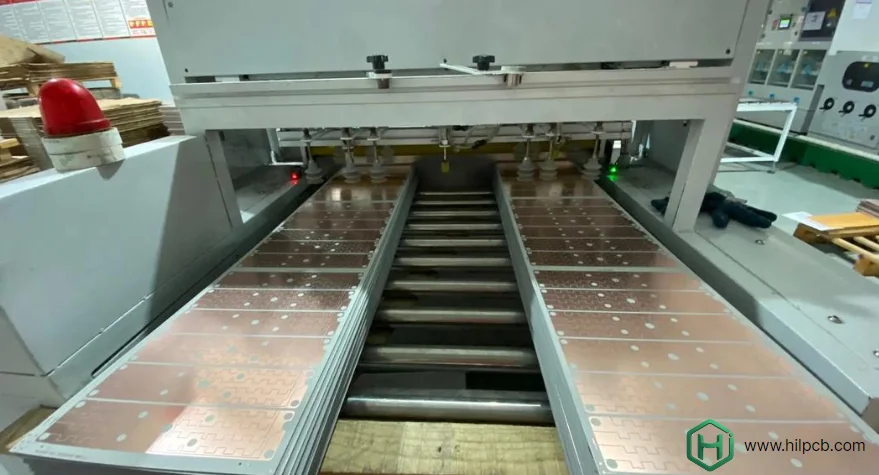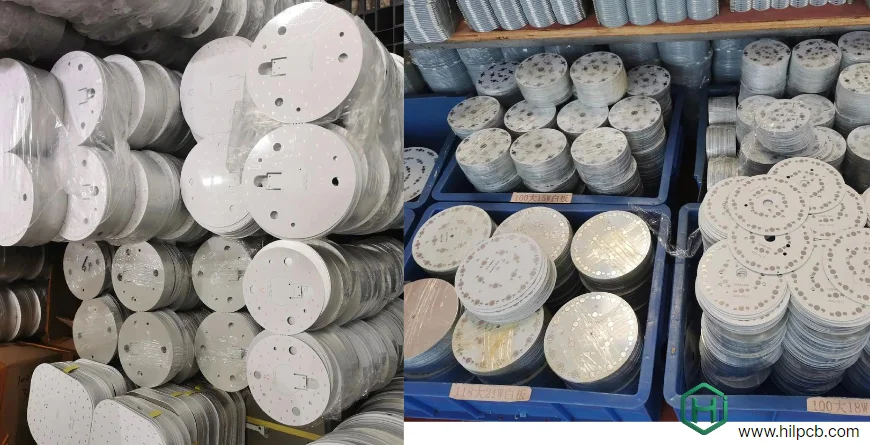Scaling aluminum PCB production from prototype to high-volume manufacturing is a turning point where engineering precision meets industrial efficiency. Successful volume manufacturing requires not just capacity, but control — balancing cost, speed, quality, and flexibility as demand grows.
At HILPCB, our production ecosystem spans small-batch runs to full-scale mass manufacturing exceeding 100,000 boards monthly. Through automated infrastructure, advanced quality systems, and integrated supply chain management, we help customers scale reliably while preserving the performance standards validated during prototyping.
Understanding and Managing Production Scale
Different production volumes require distinct approaches in process control and investment strategy.
- Low-Volume (50–500 units): Ideal for pilot runs or specialized applications. Shared lines and flexible tooling ensure quick delivery and low setup costs, often for single and double-layer PCBs.
- Mid-Volume (500–5,000 units): Suitable for early commercialization. Standardized tooling and supplier consistency improve process stability — common in industrial lighting and automotive systems.
- High-Volume (5,000–50,000 units): Dedicated metal-core PCB lines, automated AOI, and synchronized logistics drive yields above 98%.
- Mass Production (50,000+ units): Fully automated flow from raw material input to testing and packaging, using MES and SPC systems to ensure consistency in LED, telecom, and consumer electronics.
2. Strategic Scaling for Aluminum PCB Production Volume
Scaling aluminum PCB production volume isn’t just about adding capacity — it’s about building a stable, predictable system that links planning, process control, automation, and supply reliability.
HILPCB’s scaling framework ensures seamless transition from prototype to mass production:
- Smart Capacity Planning – Forecast-driven scheduling reserves production slots for long-term clients, avoiding bottlenecks during demand surges.
- Process Repeatability – Optimized panel utilization, solder profiling, and in-line testing keep yield rates stable across all volume levels.
- Automation Alignment – From shared tooling in low runs to robotic AOI and automated handling in high-volume lines, investments scale with production growth.
- Supply Chain Stability – Forecast-based sourcing and dual-supplier strategies secure aluminum substrates and components for turnkey assembly.
- Quality System Integration – Certified under ISO 9001, IATF 16949, and UL, HILPCB maintains full SPC traceability and MES data visibility across every batch.
This coordinated approach gives OEMs confidence that each production scale — from pilot to full mass run — meets the same standards of quality, speed, and reliability.

3. Cost Optimization in Volume Manufacturing
Volume production achieves profitability through precision control of materials, processes, and yield.
- Material Optimization: Larger purchase volumes reduce substrate, dielectric, and component costs by up to 30%.
- Panel Efficiency: Optimizing layout improves panel utilization rates, reducing material waste by 15–20%.
- Tooling Amortization: Specialized jigs or test fixtures quickly pay off when distributed across thousands of units.
- Yield Improvement: Raising first-pass yield from 95% to 99% reduces rework and scrap costs dramatically.
- Automation ROI: Replacing manual inspection with AOI and flying-probe testing increases throughput 3–5× while reducing labor costs.
These improvements are cumulative — together cutting per-unit costs 25–45% from low-volume to mature high-volume runs.
4. Quality Consistency Across Scale
Scaling doesn’t excuse quality drift. Maintaining consistency across tens of thousands of boards requires disciplined systems and continuous verification.
Process Control and SPC
Real-time data collection monitors critical parameters — copper thickness, lamination pressure, and thermal resistance. Control limits trigger corrective action before deviation occurs.
Automated Inspection and Testing
AOI, X-ray, flying probe, and thermal imaging validate fabrication integrity.
Automated traceability tags every unit with material, operator, and test data, ensuring accountability and quick root-cause analysis.
Supplier Quality Assurance
Approved vendor programs, incoming material audits, and performance tracking guarantee upstream stability. Dielectric consistency is particularly vital for high-thermal PCBs where minor variance affects thermal conductivity.
5. Capacity, Lead Time, and Supply Chain Coordination
Balancing output and responsiveness determines success at scale.
- Dynamic Capacity Allocation: Dedicated lines for high-volume products; flexible cells for smaller orders.
- Lead Time Control: Forecast-based procurement shortens aluminum and copper material cycles by up to 40%.
- Demand Variability Management: Buffer inventory and temporary labor absorb seasonal peaks.
- Supply Chain Visibility: ERP-integrated dashboards track WIP, quality metrics, and OTD (On-Time Delivery) performance in real time.
- Synchronized Logistics: Just-in-time component delivery reduces warehouse overhead while maintaining production continuity.
Facilities providing box-build assembly benefit from unified scheduling — ensuring PCB fabrication, assembly, and packaging align seamlessly.
6. Scalable Assembly and Testing Ecosystem
As production scales from prototype to mass manufacturing, PCB assembly and testing processes must evolve to maintain precision and consistency. At HILPCB, advanced automation ensures smooth scalability, combining high-speed placement, controlled soldering profiles, and inline inspection to achieve repeatable quality across all volumes. Our fully automated SMT lines handle miniature components down to 01005 size, while optimized reflow curves guarantee uniform solder joints on aluminum and hybrid substrates.
Comprehensive testing infrastructure supports every stage of validation. Each board undergoes in-circuit testing, functional testing, and thermal performance verification using dedicated fixtures and automated systems. Real-time monitoring dashboards track yield, identify anomalies, and ensure every product conforms to exact design specifications before shipment.
All production data is captured through MES (Manufacturing Execution Systems) and integrated into centralized analytics platforms. This allows engineers to identify recurring patterns, enhance process reliability, and implement continuous improvements that strengthen long-term product performance. Through this integrated ecosystem, HILPCB ensures every assembled PCB delivers electrical accuracy, mechanical integrity, and market-ready dependability.
7. Multi-Technology Production Capability
Although aluminum PCBs dominate thermal management applications, volume production often involves hybrid technologies. Our scalable system accommodates multiple PCB types to support complete product ecosystems:
- FR4 PCB for control and signal circuits
- HDI PCB for compact high-density interconnects
- Ceramic PCB for extreme heat resistance
- Rigid-Flex PCB for space-limited or dynamic assemblies
Unified manufacturing control ensures these different board types maintain matching quality and performance standards under one integrated process.
Conclusion
Scaling aluminum PCB production from small-batch to mass manufacturing is a journey of precision, discipline, and collaboration. Every growth stage — from early pilot builds to fully automated mass lines — demands planning across processes, people, and partnerships.
HILPCB delivers scalable manufacturing solutions combining thermal engineering expertise, automation, and robust quality management. Whether your needs involve hundreds or hundreds of thousands of units, we provide consistent performance, transparent communication, and supply chain stability to support your expansion confidently.

